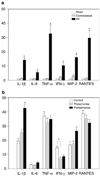Renal ischemia-reperfusion leads to long term infiltration of activated and effector-memory T lymphocytes
- PMID: 19092796
- PMCID: PMC2676145
- DOI: 10.1038/ki.2008.602
Renal ischemia-reperfusion leads to long term infiltration of activated and effector-memory T lymphocytes
Abstract
It is well-established that significant ischemia-reperfusion injury during kidney transplantation results in increased incidence of long-term fibrosis and rejection. To test for a role of T cell infiltration and activation following ischemic injury, we induced both bilateral and unilateral renal ischemia in mice, followed by reperfusion, and then isolated mononuclear cells. Analysis of these cells by flow cytometry showed that 2 weeks after bilateral ischemia there was a significant increase of CD8(+) T cells. Furthermore, both CD4(+) and CD8(+) T cells infiltrated the injured kidney 6 weeks after unilateral ischemia. These T cells had increased expression of CD69(+) and CD44(hi)CD62L(-), markers of activation and effector-memory, respectively. CD4(+)NK1.1(+) and CD19(+) B cells were decreased in percentage both 6 and 11 weeks after bilateral or unilateral injury. There was a significant upregulation of IL-1beta, IL-6, TNF-alpha, IFN-gamma, MIP-2, and RANTES expression, measured by real-time PCR, 6 weeks after unilateral renal ischemia, further indicating T cell activation. Depletion of CD4(+) and CD8(+) T cells before ischemia caused less medullary damage and reduced kidney IFN-gamma expression, whereas their depletion following ischemia increased kidney IL-1beta; however, depletion of these cells had no effect on histological damage to the kidney. Our study demonstrates that moderate or severe kidney ischemia induces long-term T lymphocyte infiltration and cytokine/chemokine upregulation, leading to kidney structural changes.
Figures








References
-
- Tilney NL, Guttmann RD. Effects of initial ischemia/reperfusion injury on the transplanted kidney. Transplantation. 1997;64:945–947. - PubMed
-
- Humes HD. Acute renal failure: prevailing challenges and prospects for the future. Kidney Int. 1995;50:S26–S32. - PubMed
-
- Terasaki PI, Cecka JM, Gjertson DW, et al. survival rates of kidney transplants from spousal and living unrelated donors. N Engl J Med. 1995;333:333–336. - PubMed
-
- van Es A, Hermans J, van Bockel JH, et al. Effect of warm ischemia time and HLA (A and B) matching on renal cadaveric graft survival and rejection episodes. Transplantation. 1983;36:255–258. - PubMed
-
- Sanfilippo F, Vaughn WK, Spees EK, et al. The detrimental effects of delayed graft function in cadaver donor renal transplantation. Transplantation. 1984;38:643–648. - PubMed
Publication types
MeSH terms
Substances
Grants and funding
LinkOut - more resources
Full Text Sources
Medical
Research Materials
Miscellaneous

